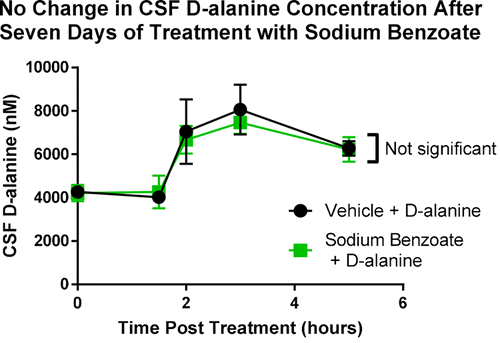当前位置:
X-MOL 学术
›
ACS Chem. Neurosci.
›
论文详情
Our official English website, www.x-mol.net, welcomes your feedback! (Note: you will need to create a separate account there.)
Lack of Effect of Sodium Benzoate at Reported Clinical Therapeutic Concentration on d-Alanine Metabolism in Dogs.
ACS Chemical Neuroscience ( IF 5 ) Pub Date : 2018-06-19 , DOI: 10.1021/acschemneuro.8b00229 Michael Popiolek , Brendan Tierney , Stefanus J Steyn , Michael DeVivo
ACS Chemical Neuroscience ( IF 5 ) Pub Date : 2018-06-19 , DOI: 10.1021/acschemneuro.8b00229 Michael Popiolek , Brendan Tierney , Stefanus J Steyn , Michael DeVivo

|
Cognitive decline and psychosis have been hypothesized to be mediated by N-methyl-d-aspartate receptor (NMDAR) hypofunction. Consistent with this hypothesis, chronic treatment with d-alanine, a coagonist at the glycine site of the NMDAR, leads to an improvement of positive and cognitive symptoms in schizophrenic patients. d-alanine is oxidized by d-amino acid oxidase (DAAO); thus, an inhibitor of DAAO would be expected to enhance d-alanine levels and likewise lead to desirable clinical outcomes. Sodium benzoate, on the basis of d-amino acid inhibition, was observed to display beneficial clinical effects in schizophrenic and Alzheimer's patients. However, in the clinical pilot studies using sodium benzoate, d-amino acids were not quantified to verify that sodium benzoate's efficacy was mediated through DAAO inhibition. In this study, d-alanine content was monitored in cerebral spinal fluid (CSF) of dogs treated with daily injections of d-alanine (30 mg/kg) alone and in combination with sodium benzoate (30 mg/kg) for seven consecutive days. We reasoned that the cerebral spinal fluid d-alanine quantity is reflective of the brain d-alanine levels and it would increase as a consequence of DAAO inhibition with sodium benzoate. We found that d-alanine treatment lead to maximal concentration of 7.51 μM CSF d-alanine level; however, coadministration of sodium benzoate and d-alanine did not change CSF d-alanine level beyond that of d-alanine treatment alone. As a consequence, we conclude that clinical efficacy associated with chronic administration of sodium benzoate in schizophrenic and Alzheimer's patients is likely not mediated through inhibition of DAAO.
中文翻译:

在报告的临床治疗浓度下,苯甲酸钠对狗的d-丙氨酸代谢缺乏影响。
认知能力下降和精神病被认为是由N-甲基-d-天冬氨酸受体(NMDAR)功能低下介导的。与该假设一致,d-丙氨酸(NMDAR甘氨酸部位的激动剂)的长期治疗可改善精神分裂症患者的阳性和认知症状。d-丙氨酸被d-氨基酸氧化酶(DAAO)氧化; 因此,可以预期DAAO的抑制剂会提高d-丙氨酸水平,并同样会导致理想的临床结果。据观察,基于d-氨基酸抑制作用的苯甲酸钠在精神分裂症和阿尔茨海默氏病患者中显示出有益的临床效果。但是,在使用苯甲酸钠的临床先导研究中,未对d-氨基酸进行定量以验证苯甲酸钠的功效是通过DAAO抑制作用介导的。在这项研究中,连续7天每天监测单独注射d-丙氨酸(30 mg / kg)并与苯甲酸钠(30 mg / kg)组合治疗的狗的脑脊髓液(CSF)中的d-丙氨酸含量。我们认为脑脊髓液中的d-丙氨酸含量可以反映出大脑中的d-丙氨酸含量,并且由于苯甲酸钠对DAAO的抑制作用,其含量会增加。我们发现,d-丙氨酸处理导致CSF d-丙氨酸水平的最大浓度为7.51μM。但是,苯甲酸钠和d-丙氨酸的共同给药并不能改变CSF d-丙氨酸的水平,而不仅仅是单独的d-丙氨酸治疗。结果,我们得出结论,在精神分裂症和阿尔茨海默氏病患者中,与苯甲酸钠的长期给药有关的临床疗效可能不通过抑制DAAO来介导。
更新日期:2018-06-12
中文翻译:

在报告的临床治疗浓度下,苯甲酸钠对狗的d-丙氨酸代谢缺乏影响。
认知能力下降和精神病被认为是由N-甲基-d-天冬氨酸受体(NMDAR)功能低下介导的。与该假设一致,d-丙氨酸(NMDAR甘氨酸部位的激动剂)的长期治疗可改善精神分裂症患者的阳性和认知症状。d-丙氨酸被d-氨基酸氧化酶(DAAO)氧化; 因此,可以预期DAAO的抑制剂会提高d-丙氨酸水平,并同样会导致理想的临床结果。据观察,基于d-氨基酸抑制作用的苯甲酸钠在精神分裂症和阿尔茨海默氏病患者中显示出有益的临床效果。但是,在使用苯甲酸钠的临床先导研究中,未对d-氨基酸进行定量以验证苯甲酸钠的功效是通过DAAO抑制作用介导的。在这项研究中,连续7天每天监测单独注射d-丙氨酸(30 mg / kg)并与苯甲酸钠(30 mg / kg)组合治疗的狗的脑脊髓液(CSF)中的d-丙氨酸含量。我们认为脑脊髓液中的d-丙氨酸含量可以反映出大脑中的d-丙氨酸含量,并且由于苯甲酸钠对DAAO的抑制作用,其含量会增加。我们发现,d-丙氨酸处理导致CSF d-丙氨酸水平的最大浓度为7.51μM。但是,苯甲酸钠和d-丙氨酸的共同给药并不能改变CSF d-丙氨酸的水平,而不仅仅是单独的d-丙氨酸治疗。结果,我们得出结论,在精神分裂症和阿尔茨海默氏病患者中,与苯甲酸钠的长期给药有关的临床疗效可能不通过抑制DAAO来介导。



























 京公网安备 11010802027423号
京公网安备 11010802027423号